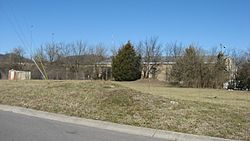Brick Church Mound and Village Site facts for kids

A small section of undeveloped land
|
|
| Location | Nashville, Tennessee, Davidson County, Tennessee, |
|---|---|
| Region | Davidson County, Tennessee |
| Coordinates | 36°14′50.89″N 86°46′32.48″W / 36.2474694°N 86.7756889°W |
| History | |
| Founded | 1000 CE |
| Abandoned | 1499 |
| Cultures | Mississippian culture |
| Site notes | |
| Excavation dates | 1877, 1969, 1971-2001 |
| Archaeologists | Frederic Ward Putnam |
| Architecture | |
| Architectural styles | Platform mounds, palisade, |
| Responsible body: private | |
The Brick Church Mound and Village Site (also known as 40DV39) is an ancient place in Nashville, Tennessee. It was once a village built by the Mississippian culture. This culture lived in what is now the southeastern United States a long time ago.
Archaeologists, who are like history detectives, have studied this site. One of the first to explore it was Frederic Ward Putnam in the late 1800s. Later, in the early 1970s, some special clay statues (ceramic figurines) were found here. These statues are now on display at the Frank H. McClung Museum. The site was added to the National Register of Historic Places in 1973. This list helps protect important historical places. However, despite being on the list, much of the site was later built over for homes and a church.
The Ancient Village
The Brick Church Pike Mounds Site was a village with several large earth mounds. These mounds were like big, flat-topped hills built by people. The village also had a tall fence, called a palisade, all around it for protection.
The biggest mound, called Mound A, was about 23 feet (7.0 m) high. It was also very wide, measuring about 155 feet (47 m) by 147 feet (45 m). There were other smaller mounds too. Near the main mound, people found many stone box graves. These were special burial places made from stone slabs.
Most villages from this time were built near small rivers or streams. Larger sites like this one offered more safety during difficult times. Even though these villages were independent, they shared similar ways of life and art. Other nearby sites like Sellars, Old Town, and Mound Bottom were connected in this way.
Frederic Ward Putnam first wrote about the Brick Church Pike Mounds in 1878. For many years after that, the site was mostly used for farming. But in the late 1900s, much of it was cleared for new houses and a church. Luckily, archaeologists were able to do "salvage archaeology" during this time. This means they quickly dug and studied the site before it was destroyed.
Digging for Clues (Excavations)
In 1877, Frederic Ward Putnam and his team dug a tunnel into Mound A. They were looking for a burial chamber inside. When they didn't find one, they filled in their tunnel and put the mound back the way it was. Putnam wrote about his findings in 1878.
Almost a hundred years later, in 1969, Dr. Charles Fletcher from Vanderbilt University did some small digs at the site. His findings were never fully published.
Amazing Discoveries
A few years later, in 1971, a young person found something amazing. They discovered a unique set of clay statues, called ceramic figurines, at the site. A local archaeologist named John Dowd was called to investigate. He started the first digs where photos were taken to record everything.
Dowd's team found a clay floor from an ancient house that had burned down. This house was about 17 feet (5.2 m) long and 8 feet (2.4 m) wide. Inside, they found pieces of 11 different clay figures. These included a male and female adult, and two children of each gender. The male figure had a special hairstyle, like those seen on warrior images from the Southeastern Ceremonial Complex. The figures were sitting cross-legged with their hands on their knees. This is similar to other stone statues found in the Tennessee-Cumberland area.
John Dowd was able to get the figurines from the young person who found them. He then loaned them to the Frank H. McClung Museum at the University of Tennessee in Knoxville. You can see them on display there today!
Throughout the 1970s, another archaeologist named Robert Jolley also dug at the site. He found many examples of Mississippian culture pottery. This included everyday pots and finer, more decorated ones. They also found many stone tools, like hoes for farming and a dagger made from a special stone called Dover chert. In 1999, during another dig, they found even more items, including a unique owl-shaped rattle with holes in it.


